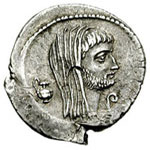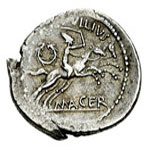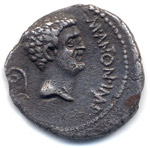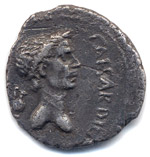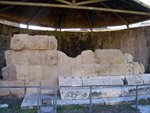Posthumous Portrait Coins of Caesar
RRC 480/22 © CNG 2004
Obverse: Bearded head of M. Antonius right, wearing veil; before lituus; behind, jug. Border of dots
Reverse: Desultor right, holding reins in left hand and whip in right hand; behind, palm-branch and wreath; above P·SEPVLLIVS; below, MACER. Border of dots
RRC 488/1
Obverse: Head of M. Antonius right, bearded; behind, lituus; before M·A![]() ON·IMP
or M·A
ON·IMP
or M·A![]() O·IMP
downwards. Border of dots.
O·IMP
downwards. Border of dots.
Reverse: Laureate head of Caesar right; behind, jug;
before, CAESAR·DIC downwards. Border of dots.
After Caesar's death the college of moneyers continued to mint coins featuring Caesar's image with some changes to his title and to his portrait. Veiled portraits of Caesar (RRC 480/12-16, 19-20) are commonly attributed to the period immediately after 15th March 44 BC. They are believed to highlight either his religious role as Pontifex Maximus or to depict an image of mourning, an image continued by Antony in RRC 480/22. Some of these coins continue to give his title as DICT PERPETVO (RRC 480/12-16), granted to Caesar around 15th February 44 BC. This then leaves a small period in which these coins could have been produced. They were either minted in the month before his death perhaps remaining un-circulated, or they were minted following his death but before 10th April when Antony moved to abolish the dictatorship as a political office. The latter argument appears more likely given the eleven other issues that were probably minted in the two and a half months prior to his death which would have left little time for the mint to have produced the coins with the veiled portrait.
In the following year (43 BC), the successors of Caesar and even his enemies produced coins bearing their own images. The image of a leader on a coin could be used to help gain the loyalty of their users. There was also a growing trend for Imperators and their lieutenants to strike independently of the central Roman mint. This not only met the immediate financial needs of armies in the field but also allowed commanders to assert the legitimacy of their right to lead their troops (Stewart 1997:186). This sense of legitimacy was crucial in 44/43 BC with the need to secure the loyalty of both trained veteran soldiers and new recruits.
The use of double-headed coins began in 43 BC. The combination of two portraits displayed political alliances and made clear dynastic statements (Wallace-Hadrill 1986:72). Both Antony and Octavian joined their portrait with that of the deceased Caesar. Antony's issue (RRC 488/1) links the two men by the use of religious symbols. The image of Caesar is accompanied by a jug and Antonys by a lituus. These symbols had come to stand not only for religious offices but also as a legitimising symbol of power. In Octavian's issue RRC 490/2 and 4 his portrait is accompanied by the legend COS PONT AVG, describing his consulate and religious offices as Pontifex and augur. Caesar's image was accompanied by the legend DICT PERP PONT MAX, (Dictator for life and Pontifex Maximus). The coins thus link Octavian, to the highest political and religious offices. Double-portrait coins were also used to commemorate the formation of the triumvirate between Antony, Octavian and Lepidus (RRC 492/1-2 and 493). They named the men as IIIVIR R P C, and again employed religious symbols or titles.
The imagery used to portray Caesar's image developed from a traditional veristic style to one that was more idealised and classicising (Toynbee 1957:6). RRC 535 issued in 38 BC by Octavian, portrayed his father as a god and himself as the son of a god. The legend accompanying Caesar's portrait reads DIVOS IVLIVS (the divine Julius) and Octavian's accompanying legend reads CAESAR DIVI F (son of the divine Caesar). This issue was the first of many to claim this link and as such develops the imagery of Caesar to fit this concept. Caesar's portrait becomes more youthful and his features less realistic, with the nose and forehead in a straighter line and the absence of the characteristic folds in his neck. By 12 BC his image becomes more like a young god, complete with a full head of hair (RIC 340). This youthful godlike image created by Octavian was paralleled in other forms of art, such as sculpture, and the revival of the classical style came to characterise the art of the Augustan period.

